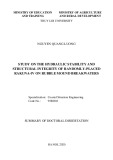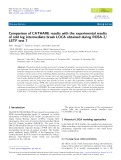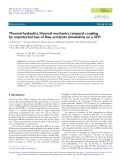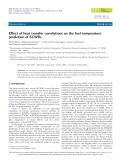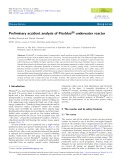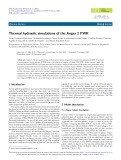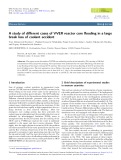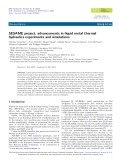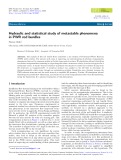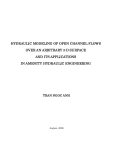
Hydraulic simulation
-
Study on hydraulic stability and structural integrity of RAKUNA-IV armour units when randomly placed on the seaward slope of a rubble mound breakwater by means of experiments on physical models in a wave flume and simulations in mathematical models. The results of the research were later applied to a specific breakwater. Recommendations and solutions were thereby put forward for the design, production and construction of RAKUNA-IV armour units when applied to rubble mound breakwaters in reality.
 27p
27p  trinhthamhodang7
trinhthamhodang7
 31-08-2020
31-08-2020
 39
39
 2
2
 Download
Download
-
The paper presents the modeling of the Test Facility ROSA-2/LSTF in the calculation code CATHARE 2.V2.5. OECD/NEA ROSA-2 Project Test 7 was conducted with the Large Scale Test Facility on June 14, 2012. The experiment simulated the thermal-hydraulic responses during a PWR 13% cold leg Intermediate Break Loss Of Coolant Accident (IBLOCA).
 8p
8p  christabelhuynh
christabelhuynh
 30-05-2020
30-05-2020
 19
19
 1
1
 Download
Download
-
In this paper, we propose an analysis of the impact of spatial variation and temporal evolution of thermal properties of fuel pins on a CFV-like core behavior during an ULOF accident. These effects are usually neglected under some a priori conservative assumptions.
 8p
8p  christabelhuynh
christabelhuynh
 30-05-2020
30-05-2020
 13
13
 1
1
 Download
Download
-
In this paper, we present a numerical analysis of the effect of different heat transfer correlations on the prediction of the cladding wall temperature in a supercritical water reactor at nominal operating conditions. The neutronics process with temperature feedback effects, the heat transfer in the fuel rod, and the thermal-hydraulics in the core were simulated with a three-pass core design.
 11p
11p  christabelhuynh
christabelhuynh
 30-05-2020
30-05-2020
 24
24
 1
1
 Download
Download
-
The results of simulated transients for three typical PWR accidents are presented: a turbine trip with station blackout, a large break loss of coolant accident and a small break loss of coolant accident. The analyses show that the safety criteria are respected and that the reactor quickly reaches a safe shutdown state without operator action and external power.
 10p
10p  christabelhuynh
christabelhuynh
 31-05-2020
31-05-2020
 39
39
 1
1
 Download
Download
-
In the present work, the thermal hydraulic RELAP5-3D code was used to develop a model of this reactor. The model was performed using geometrical and material data from the Angra 2 final safety analysis report (FSAR).
 8p
8p  christabelhuynh
christabelhuynh
 31-05-2020
31-05-2020
 23
23
 1
1
 Download
Download
-
The paper covers the results of VVER core reflooding studies in fuel assembly (FA) mockup of 126 fuel rod simulators with axial power peaking. The experiments were performed for two types of flooding. The first type is top flooding of the empty (steamed) FA mockup.
 11p
11p  christabelhuynh
christabelhuynh
 30-05-2020
30-05-2020
 38
38
 2
2
 Download
Download
-
This paper will present the progress in the project with respect to liquid metal cooled reactor thermal-hydraulics (liquid metal heat transfer, fuel assembly thermal-hydraulics, pool thermal-hydraulics, and system thermal-hydraulics).
 8p
8p  christabelhuynh
christabelhuynh
 29-05-2020
29-05-2020
 12
12
 3
3
 Download
Download
-
The present work aims at improving our understanding of nefarious reorganisation phenomena observed by numerous studies in the flow large-scale structures. 3D simulations allowed identifying two distinct reorganisations consisting in a sign change for either a transverse velocity in rod-to-rod gaps or for a subchannel vortex.
 7p
7p  christabelhuynh
christabelhuynh
 29-05-2020
29-05-2020
 13
13
 1
1
 Download
Download
-
The goal of this study is to demonstrate and quantify the impact that the uncertainty in thermophysical properties has on key metrics of thermal hydraulic importance for MSRs, in particular on the heat transfer coefficient. In order to achieve this, computational fluid dynamics (CFD) simulations using the RANS k-ω SST model were compared to published experiment data on molten salt.
 13p
13p  christabelhuynh
christabelhuynh
 29-05-2020
29-05-2020
 21
21
 1
1
 Download
Download
-
Research objectives: To find scientific solutions for urban drainage issues and to improve river and pipe hydraulic coupling model for suitable urban application under specific conditions of strong tidal impact, heavy rainfall and rapid urbanization in Viet Nam.
 25p
25p  change03
change03
 06-05-2016
06-05-2016
 41
41
 3
3
 Download
Download
-
Average depth model has a variety of applications in hydraulic engineering, especially in applications that flow depth is much smaller than the width of the flow. In this method the vertical variation is negligible and the hydraulic variables average integrated from channel bed to the surface free for the vertical axis. in equations arising management, pure hydrostatic pressure is assumed that not really valid in the case of flow in the bed is curved and can not be described curvature effects of the bed.
 127p
127p  gauhaman123
gauhaman123
 17-11-2011
17-11-2011
 105
105
 16
16
 Download
Download
CHỦ ĐỀ BẠN MUỐN TÌM









